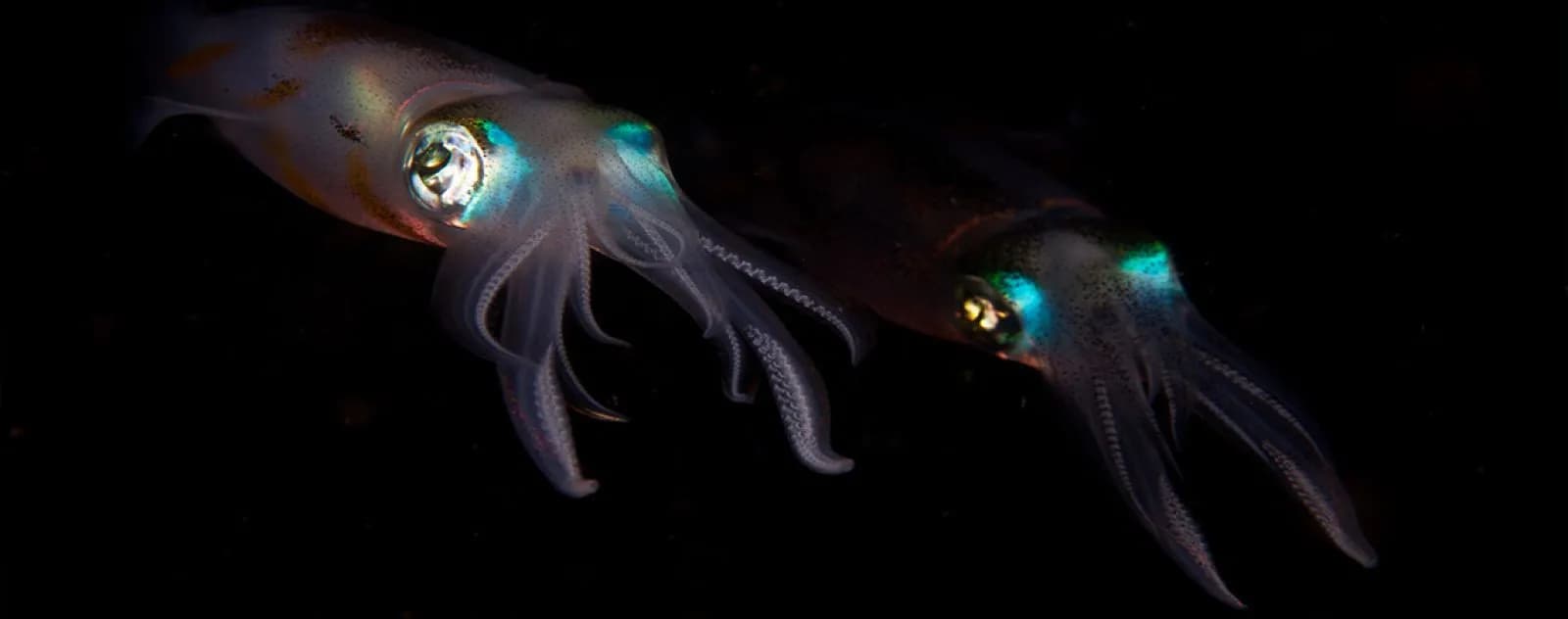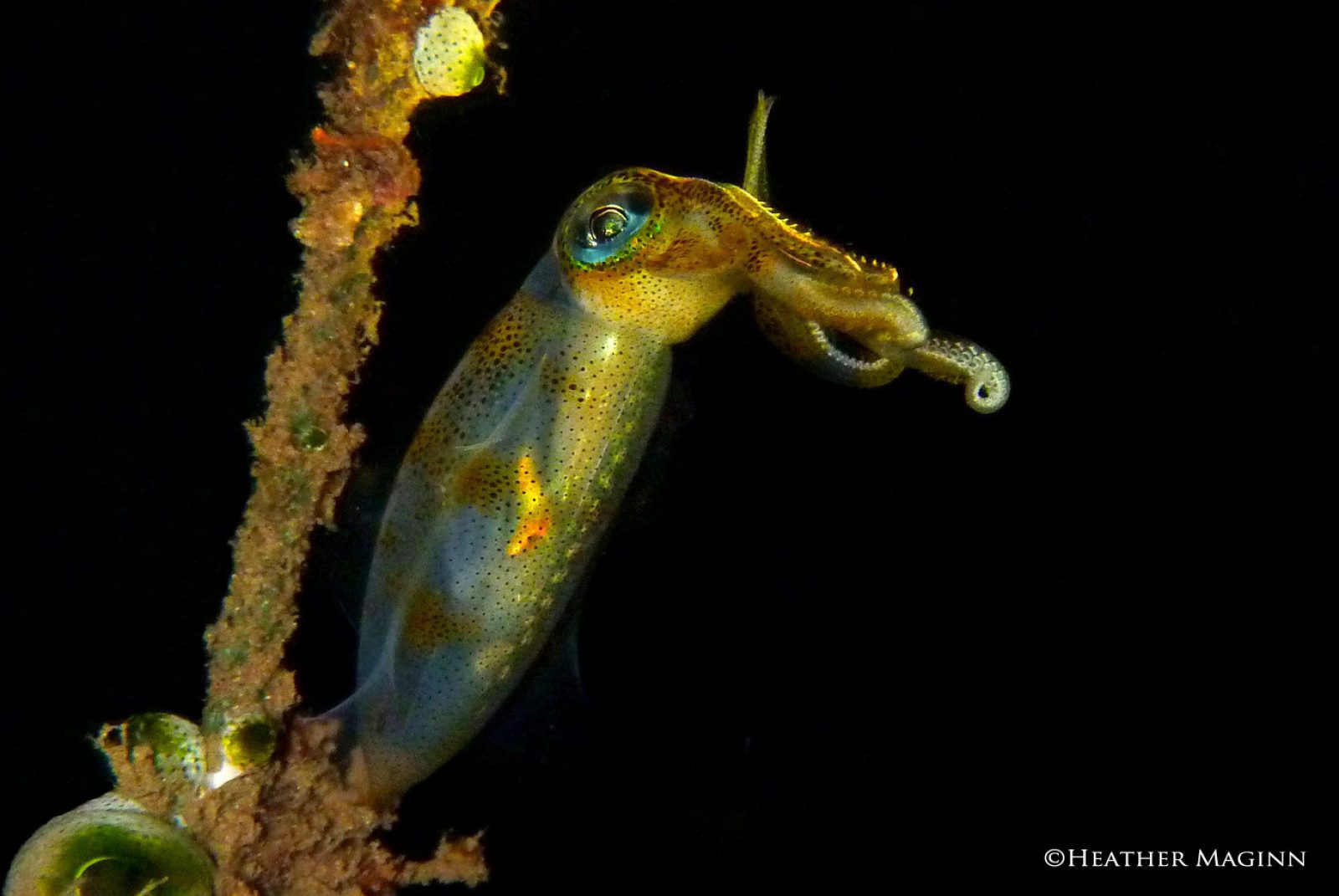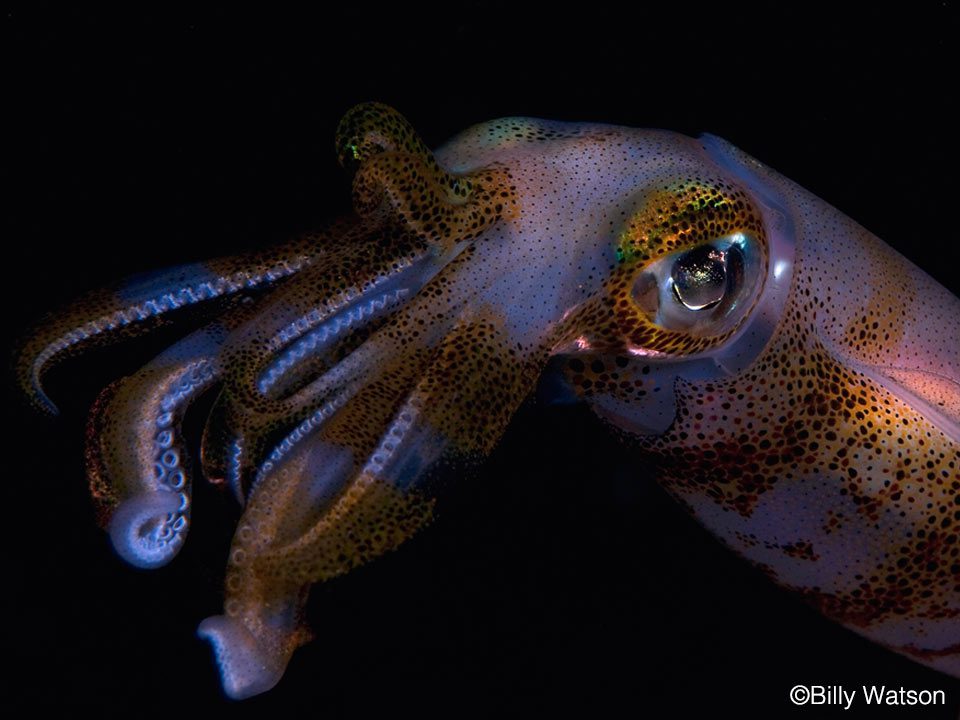Bigfin Reef Squid in Lembeh

Those who have experienced the incredible muck diving on offer in the Lembeh Strait will know all too well that cephalopods are one of the major highlights. The Lembeh Strait is home to a host of different species of octopus, cuttlefish, and squid. One of the most commonly spotted squid species is the bigfin reef squid and in this Blog, we take a closer look at this species, its behavioral traits, life cycle, where to find them and how to photograph them.
Introducing the Bigfin Reef Squid
The bigfin reef squid (Sepioteuthis lessoniana) is also known as the glitter squid or the oval squid. The common name of this species comes from their large oval fins which extend throughout the margins of the mantle. These large fins often result in these small to medium sized squids being misidentified as cuttlefish.
The fins are able to extend to an impressive 83% to 97% of the length of the mantle and they are 67% to 70% of the mantle length in width. Bigfin reef squid have a highly distinguishing narrow blue to white line at the point where the fins meet the mantle. The mantles of bigfin reef squids are cylindrical in shape and they taper to a blunt cone at the posterior.
The bigfin reef squid has eight thick arms which are unequal in length. The arms all taper to a narrow point and have 2 rows of suckers. In the males, the left arm of pair IV is modified into a sexual organ known as the hectocotylus!
Social Behavior
Bigfin reef squids are known for their complex social interactions. This species is found in groups (as opposed to solitary) and displays both schooling and shoaling behaviors. Very young bigfin reef squids will also stay close together (shoaling), but do not swim together parallel to each other (schooling).

Diet and Predators
Like other species in the families of squid and cuttlefish, the bigfin reef squid feeds on fish and crustaceans. It uses its two tentacles to capture prey and its eight arms to hold the prey as it eats. Bigfin reef squid have strong curved beaks which they use when feeding on, or killing prey. However, its beak opening is relatively small, so bigfin reef squid must take small bites of any prey that they capture. They also have 7 rows of teeth which are used for breaking down food.
As well as being predators, they are also prey. The most common predators of these squid are tuna, marlin, swordfish and other large predatory fish species.
Mating
Bigfin reef squid are quite the romancers! As is common in many cephalopod species, the bigfin reef squid uses pigmented skin cells called chromatophores to change the color, pattern and texture of their skin. Specific patterns and colors are used by the male and female during mating to attract one another.
When attracting a would-be mate they flash a range of colors while making rhythmic gestures with their mantle and body. It may be that the reason for their underwater-disco-like approach to mating is because, like many cephalopods, they only mates once in its lifetime!
Fighting and Inking
When startled or when fighting with each other, these squid may produce a jet of ink and propel themselves backwards quickly using a jet of water. The ink is intended to confuse or temporarily blind the predator and to ‘hide’ the squid while it quickly shoots backward out of harm’s way.

Reproduction and Lifespan
Each female lays about 400 egg pods which take approximately three weeks to incubate. Adults may lay eggs for over three months. The squid are around only a quarter of an inch long when they hatch, but they can grow to longer than a foot (approximately 13 inches/33 centimeters).
A bigfin reef squid has a relatively short lifespan of just up to 11 months. During their life cycles, bigfin reef squid are extremely fast growing, in fact they have the fastest recorded growth rates of any large marine invertebrate. This species can reach 600 g (1.3 lb) in only four months and they can increase their body length by as much as 6% per day.
Where to Find Bigfin Reef Squid in Lembeh
It’s possible to spot this squid at all of our dive sites in the Lembeh Strait and around the entire island. Because they are commonly found near the shoreline they are often in shallow water. For the best chance of a sighting look beneath the surface (mid-water) when close to the banks of the Lembeh Strait.
Underwater Photography of Bigfin Reef Squid
Bigfin reef squid will allow for close up encounters with photographers, however they are quick to take flight when threatened. Approach this species slowly and if they begin to turn away or swim backward stay at that distance from them. The strongest photographs of the underwater creature will have the eye clearly in focus and show some of the iridescent coloration.
Elevate Your Underwater Photography at Lembeh Resort

Lembeh Resort isn’t just a dive trip; it’s your gateway to becoming an underwater photography master. Want to refine your skills and capture stunning images of the incredible marine life in Lembeh Strait? Join us at the prestigious Capturing Critters in Lembeh UW Photography Workshop 2025. Learn from world-class photo professionals and elevate your underwater photography to the next level.
Do you want to join us for the 12th annual Capturing Critters in Lembeh UW Photography Workshop 2025? Contact us for more information or you can reserve your place at reservations@lembehresort.com. Don’t miss this opportunity to transform your dives into breathtaking underwater masterpieces!
Join us at Lembeh Resort

Lembeh Resort Cliffside Villa Bedroom
Are you planning your next dive trip? Reach out to Lembeh Resort for more information about diving, accommodation, and our service rates. Email us at reservations@LembehResort. Explore Unforgettable Underwater Encounters!
Further Reading
If you enjoy reading about the fascinating marine life found in the Lembeh Strait, you may also enjoy reading some of these recent articles:



